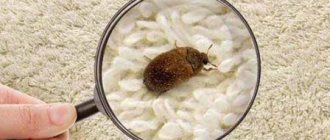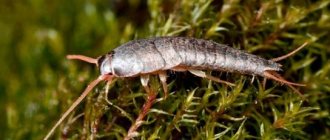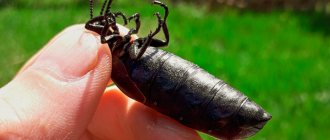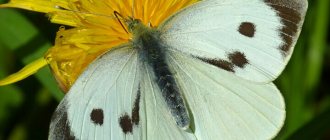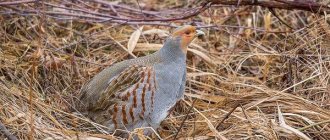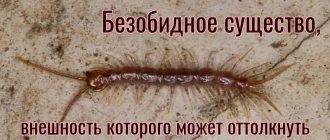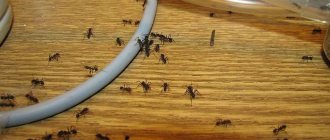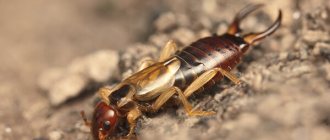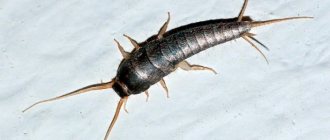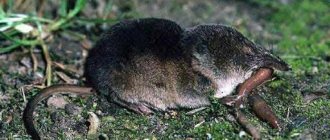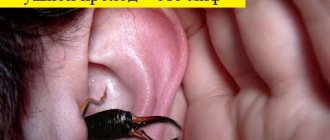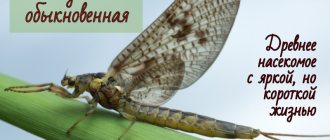Reproduction of wasps
Common wasp (Vespula vulgaris).
The breeding season takes place in autumn. Mating occurs in October. Typically, the queen mates with several males. Sperm remains in the body of the uterus until spring. After mating, the drones and worker wasps soon die.
The queen is considered the main one in the aspen family.
In winter, females hibernate. In spring, the queen looks for a suitable place for a nest. First she builds several cells. The cells are interconnected and form a honeycomb. The female hangs this nest from the ceiling of some building or from a tree branch. Then she lays one egg in each cell. The eggs take about 6 days to develop. The larvae that emerge from the eggs are fed by the mother with chewed insects. The larva wraps itself in a web and turns into a pupa. Adults hatch 3 days after creating a cocoon.
Wasps are social insects.
Eggs that have not been fertilized give life to drones, and from fertilized eggs worker wasps or queens emerge, it all depends on what food the larvae ate.
When the workers emerge from the pupa, the queen stops obtaining food and only lays eggs. The number of testicles laid by the uterus is 300 per day. In July, young wasps take care of feeding the larvae and building a nest, while the queen only lays eggs. Food for the female and larvae is obtained by workers. In the fall, the eggs do not hatch from worker wasps, but from males and females.
Lifestyle and habitat
Wasps are found in any area. These insects perhaps do not adapt to cold, unsuitable areas for existence. They always live close to humans, thereby providing themselves with constant food. Wide populations of wasps are present in almost all countries of Eurasia, North Africa, Australia, Mexico and Argentina. They are not found except in the Arctic and Antarctica, as well as in deserts.
Representatives of different species tend to build a social hierarchical system. Most wasps live in groups. Insects form close-knit colonies and conduct joint life activities. In some aspen families there are 15-20 thousand individuals. Each colony has a social structure that involves stratification into classes and the definition of responsibilities.
In addition to social ones, there are solitary individuals that do not depend on others and do not have a nest or swarm. These are predatory insects that catch beetles and spiders larger than themselves. They sting victims with their sting and release poison, after which they are paralyzed.
The predominant percentage of colony members are working wasps. They search for food for themselves and the larvae, and protect the nest from attack by other insects. Moreover, such individuals are quite aggressive. If they are slightly disturbed, they will immediately attack, and if they sense a real threat to their home, the entire swarm will fly out.
Lifestyle of common wasps
Wasps lead a social lifestyle. They feed on a variety of insects, fruits and juices from fruits and meat.
The queen lives on average 10 months, and the life expectancy of worker wasps and drones is about 4 weeks.
Vespiary. These are often found under the roof of a house or on a balcony.
There are approximately 60 species of paper wasps in Central Europe. The largest representative of this family is the hornet.
Since wasps are social insects, they live in numerous colonies. The queen builds a nest, which is a structure made of paper-like material. Wasps produce this material by mixing crushed wood with their own saliva.
How is it different from a bee?
Visually distinguishing a wasp and a bee is quite easy, you just have to take a closer look at the insects. Despite the fact that the color of the insects is similar, the color of the wasp is brighter and more contrasting. The bee against the background of the wasp looks more faded, and the pattern on the body is more blurred and smeared. The body of the bee is stockier, there is no “wasp waist”. In addition, there is much more hair on the body of a bee.
wasp sting
In addition to appearance, insects have other differences:
- The bee has a jagged sting, while the wasp has a smooth one, so that it can use it repeatedly without harm to itself;
- bees eat pollen, nectar and honey, the wasp's diet is much more varied;
- bees are usually smaller in size.
Bees are calmer insects, while wasps are annoying and aggressive.
Wasp self-defense
After a wasp sting, a person's skin swells.
To protect themselves, these insects use 2 methods. A passive defense is their bright colors, which repel lizards, birds and other small mammals. Enemies associate this color with unpleasant taste sensations, so after several attempts, they stop hunting wasps. And the second method of protection is active - the use of a sting. The sting is a curved tube without barbs, so when the wasp plunges its weapon under the skin of the enemy and injects poison, it does not die like a bee, but calmly removes the sting and can attack again.
The benefits and harms of insects
The wasp itself is not at all dangerous to humans, however, as a result of an attack by a female, there is a risk of developing an allergic reaction.
A wasp sting is manifested by the following unpleasant symptoms:
- swelling;
- redness and inflammation of the skin;
- pain;
- itching;
- slight malaise;
- slight increase in body temperature.
If a wasp stings, urticaria may occur, and in difficult cases, Quincke's edema develops at lightning speed and anaphylactic shock occurs.
If a wasp stung for the first time, and everything ended well, this does not guarantee that a subsequent insect bite will pass without consequences. Wasp venom can accumulate in the body and cause sensitization. What to do if bitten by a wasp - first aid for a wasp sting.
These insects bring not only harm, but also benefit. They actively fight pests in greenhouses, vegetable gardens, and orchards. Some biologists argue that many people are unaware of the existence of certain species of spiders and beetles thanks to predators colored with black and yellow stripes.
In addition, today scientists continue to actively research the properties of wasp venom against cancer cells. It's all about the special structure of the protein it contains, supposedly this particular substance allows you to destroy malignant cells.
Wasps diet
Sweet fruits attract wasps.
When a large number of garden and household insects multiply, wasps become very useful because they eat these pests. Worker wasps suck sweet juices and nectar from plants. In autumn, the number of small insects decreases, so wasps climb into houses in search of prey. The workers obtain food for the queen and larvae, and themselves feed on what the larvae regurgitate.
Description
The wood wasp is a medium-sized insect; the length of the working wasp is 13-15 mm. The uterus grows to 18 mm. The color is bright, black and yellow. The color is predominantly black. The body is divided into 3 parts - head, chest and cone-shaped abdomen, between the latter there is a very thin transition. The head is black, lowered, with straight mustaches and powerful jaws. The wings are narrow and transparent. The insect uses a thin and straight sting for self-defense and to attack the victim.
Wasp observations
Wasps build nests in hollows and on tree branches in forests and gardens. They may also take up residence in an attic or an abandoned vole hole. They often attach their nests to window frames.
Wasps build their “houses” from shredded wood and their own saliva.
New colonies are formed due to the fact that the queen lays eggs, from which males and females emerge in the fall. They go on a mating flight and look for partners. After fertilization, the males die, and the females overwinter and give birth to a new colony. The nest of some wasp species can contain up to 20 thousand individuals. The types of wasps differ due to a clear pattern on the front of the head, which can have different shapes. In the common wasp, this pattern has the appearance of an anchor.
Varieties
There are a large number of wasp species. They may differ from each other in the degree of color, shade and even feeding habits. But there are two clear classifications: solitary and social.
The way of life depends on the names
Solitary wasps coexist with other individuals of their species only when they need fertilization. They can build nests, but feel comfortable in different burrows and depressions. Even the larvae of single species are laid so that they do not touch each other.
Social wasps. They live in a colony, which is founded by the queen. She lays the first generation, fattens it and raises it. Then a family appears, in which each individual occupies a certain place and has a certain role.
Characteristic features of the OS
Wasps have two pairs of transparent wings, with the help of which they make swift and swift flights. They have 3 pairs of jointed legs with claws, with the help of which wasps cling to the surface. Wasps have complex compound eyes that provide them with excellent vision.
Common wasp: image in multiple magnification.
The mouthparts of wasps are very powerful - queens can crush wood with their jaws, from which they then build their nests. The nest is made of a paper-like material and is a system of cells in which eggs are laid.
Species diversity
The varieties of these thin-waisted insects are surprising in their heterogeneity. After all, besides the classic striped wasp, which flies everywhere and doesn’t seem to be afraid of anyone, there are other species. Some of them are not very similar to their counterparts.
Wasps in Russia are no less diverse than similar insects in other regions. It is not possible to describe all types here, but typical and unusual types can be:
- Flower wasp. This solitary insect leads the lifestyle of a bee. Representatives of this group are very small in size - no more than 1 cm. This insect is colored like a typical black and yellow wasp. The flower wasp got its name because it feeds on pollen and nectar. She even has a long proboscis, which is so convenient for drinking nectar. However, this wasp does not carry pollen on legs, like bees, but in the crop.
- Sand wasps. These insects got their name based on their lifestyle. They dig their burrows in the ground, mostly sandy. All burrowing insects are characterized by the presence of a large head and hypertrophied jaws. Sand wasps are no exception. They look scary, but their danger to humans is not great. It is practically a black wasp and only the abdomen has yellow or grayish stripes. For their ability to deliver precise blows to an enemy larger than them, these wasps are commonly called cicada killers.
- German wasp, or German wasp. They are sometimes confused with ants because the female wasps do not have wings. Because of this terrestrial lifestyle, German women are sometimes called velvet ants. This name is due to the fact that the body of females is covered with hairs, which evokes an association with velvet. These wasps also differ in color - they are bright red with black spots. This is also a kind of warning coloring, because these insects also have poison. However, the male is predominantly black or brown with red spots. These wasps invade other people's burrows, laying their eggs there. The hatched larvae feed on the host's eggs. After leaving the nest, they drink nectar from flowers or juice from insect corpses. So the dark wasp on the flower is a male or a young female.
There is also a species called the wasp fly. In fact, it is really a fly, but it is colored like a wasp or a bee. This cunning fly can be distinguished by the absence of a thin waist. In addition, she has only two pairs of wings, which is a typical fly feature. So this fly does not have the structure of a wasp, it mimics only the color of its body.
Otherwise, this fly is called a hoverfly. This insect received this name for the characteristic murmuring sound made by its wings while hovering over a flower. These flies feed on pollen and nectar. They have no poison, but the birds don’t touch them because they don’t understand entomology at all. This wasp-like fly enjoys all the benefits of stinging insects, which is also beneficial for plants, since the hoverfly is a good pollinator.
Eyes
The eyes are complex in structure and are always well developed. Between them there are three small eyes, which are arranged in the form of a triangle. But science knows species that are born completely blind or without the last small eyes.
The eyes are positioned so that the insect can see 180 degrees around itself. This structure is also called faceted. It perceives ultraviolet rays, the direction of polarization of light. Insects distinguish small details very poorly, but they have an excellent ability to see light blinking up to 300 Hz. For comparison, the human eye only perceives 50 Hz.
Compound eyes are motionless. They are located in recesses called capsules. They are surrounded by a ring of cuticle, holding them on the head. The eyes are located far from each other, on the sides of the head. But, thanks to three additional organs of vision, the insect sees a mosaic that forms a whole picture. Focusing, although not the same as that of a person, is sufficient to fix everything that is on the trajectory of movement. Three small additional eyes are very similar in structure to humans. There's even a pupil.
